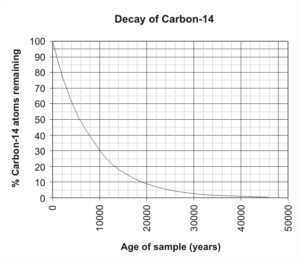Putting It Together: Exponential and Logarithmic Equations and Models
At the start of this module, you were assigned the task of analyzing a fossilized bone to determine its age. To make that estimate, you need to model for the decay rate of carbon-14.
The decay of a radioactive element is an exponential function of the form:
where,
A(t) = mass of element remaining after t years
A0 = original mass of element
k = rate of decay
t = time in years
So to create a model for the decay function of carbon-14, assume for simplicity that the sample you started with had a mass of 1g. We know that half the starting mass of the sample will remain after one half-life, which is 5,730 years. We can substitute these values for A(t), and A0 as follows:
A(t)=A0e−kt
21=(1)e−k(5730)
1n(21)=1n(e−k(5730))
1n(2−1)=(−5730k)1n(e)
−1n(2)=−5730k(1)
k≈1.21×10−4
Now you know the decay rate so you can write the equation for the exponential decay of carbon-14, and you can represent it as a graph.
 The next step is to evaluate the function for a given mass. Assume a starting mass of 100 grams, and that there are 20 grams remaining. Substitute these values into the model in the following way:
The next step is to evaluate the function for a given mass. Assume a starting mass of 100 grams, and that there are 20 grams remaining. Substitute these values into the model in the following way:
| Write the equation |
A(t)=100e−(0.000121)t |
| Substitute 20 grams for A(t) |
20=100e−(0.000121)t |
| Divide both sides by 100 |
0.20=e−(0.000121)t |
| Change into logarithmic form |
1n(0.20)=−(0.000121)t |
| Divide both sides by -0.000121 |
t=−0.0001211n(0.20) |
| Solve |
t≈13,301 years |
Now you know that it would take 13,301 years for a 100-gram sample of carbon-14 to decay to the point that only 20 grams are left. Confirm that this number makes sense by looking at the graph, and it does.
You can also determine the amount of a 100-gram sample that would remain after a given number of years, such as 8,000. To do this, substitute the number of years into the function and evaluate.
A(t)=100e−(0.000121)t
A(8000)=100e−(0.000121)(8000)≈38 grams
About 38 grams would remain after 8,000 years.
Understanding exponential functions help scientists better understand radioactive decay and provide insights into past civilizations and species.Licenses & Attributions
CC licensed content, Original
- Putting It Together: Exponential and Logarithmic Equations and Models. Authored by: Lumen Learning. License: CC BY: Attribution.
CC licensed content, Shared previously
- Radioactive decay of carbon-14. Located at: https://commons.wikimedia.org/wiki/File:Radioactive_decay_of_Carbon-14.png#/media/File:Radioactive_decay_of_Carbon-14.png. License: CC BY-SA: Attribution-ShareAlike.
 The next step is to evaluate the function for a given mass. Assume a starting mass of 100 grams, and that there are 20 grams remaining. Substitute these values into the model in the following way:
The next step is to evaluate the function for a given mass. Assume a starting mass of 100 grams, and that there are 20 grams remaining. Substitute these values into the model in the following way:
